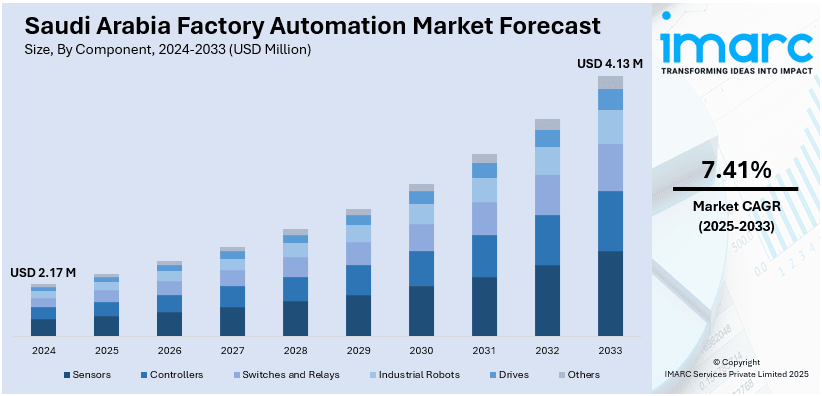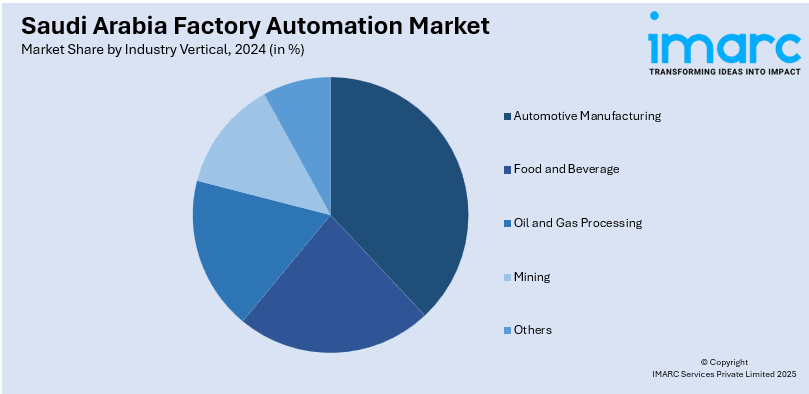
Saudi Arabia Factory Automation Market Size, Share, Trends and Forecast by Component, System Type, Industry Vertical, and Region, 2025-2033
Saudi Arabia Factory Automation Market Overview:
The Saudi Arabia factory automation market size reached USD 2.17 Million in 2024. Looking forward, IMARC Group expects the market to reach USD 4.13 Million by 2033, exhibiting a growth rate (CAGR) of 7.41% during 2025-2033. The market is driven by Saudi Arabia's Vision 2030, which fosters industrial diversification and the need for efficient production systems. Additionally, labor shortages and workforce transformation challenges are pushing the adoption of automation to maintain competitiveness and improve productivity, fueling the market. Government incentives and industrial policies aimed at promoting technological advancement further support the ongoing expansion of the Saudi Arabia factory automation market share.
|
Report Attribute
|
Key Statistics
|
|---|---|
|
Base Year
|
2024
|
|
Forecast Years
|
2025-2033
|
|
Historical Years
|
2019-2024
|
| Market Size in 2024 | USD 2.17 Million |
| Market Forecast in 2033 | USD 4.13 Million |
| Market Growth Rate 2025-2033 | 7.41% |
Saudi Arabia Factory Automation Market Trends:
Rapid Industrialization and Vision 2030
The Vision 2030 program in Saudi Arabia, which seeks to diversify the economy and lower the nation's dependence on oil, is one of the main drivers of the factory automation business. Through this vision, the kingdom is investing heavily in industries like manufacturing, mining, and logistics and is promoting the use of new technologies, such as automation systems, to improve productivity and competitiveness. The growth of industries such as petrochemicals, building, and food processing demands the use of factory automation solutions to enhance operational effectiveness, lower costs, and maintain international quality standards. Automation technologies like robotic arms, automated production lines, and control systems play a key role in addressing the growing demand for higher production levels and shorter turnaround times. Also, Saudi Arabia's geographical position as a manufacturing and logistics hub in the Middle East has also increased the demand for more efficient and scalable manufacturing solutions. With the kingdom investing heavily in industrialization as part of Vision 2030, demand for factory automation technologies is likely to increase, and hence the Saudi Arabia factory automation market growth.

Labor Shortages and Workforce Transformation
Labor shortages and the imperative of workforce transformation are major drivers for the Saudi Arabian adoption of factory automation. The nation has challenges with a relatively unskilled youth population, combined with a high reliance on foreign labor across many industries. With expanding industries comes increased demand for skilled labor, and there is an urgent need to increase productivity with fewer manual labor resources available. Automation presents a solution by reducing the dependence on human labor for physically demanding, hazardous and repetitive tasks, and enhancing efficiency in production processes. Robots and automated systems can operate around the clock, increasing production without the need for extended shifts or additional manpower. Furthermore, automation can help bridge the skills gap in the labor market, allowing workers to focus on higher-value roles while robots handle basic tasks. As Saudi Arabia remains committed to workforce development via education and training programs, automation will increasingly become crucial in reshaping the industrial labor market and fueling market growth.
Government Incentives and Industrial Policies
The Saudi Arabian government has been proactive in supporting the adoption of advanced manufacturing technologies, including factory automation, through various incentives and policies. The country has implemented a series of initiatives to promote automation in its manufacturing sectors, including tax benefits, subsidies, and financial support for technology integration. Additionally, the Saudi Industrial Development Fund (SIDF) has been instrumental in providing financing for businesses looking to invest in automation and other advanced technologies. Government policies that support economic diversification, such as those outlined in Vision 2030, also prioritize the enhancement of industrial capabilities through digital transformation. Furthermore, regulations around energy efficiency, environmental sustainability, and safety standards are driving the need for more advanced, automated systems that comply with these criteria. With continued government backing and strategic policy frameworks aimed at boosting industrial capabilities, the factory automation market in Saudi Arabia is poised for significant growth in the coming years.
Saudi Arabia Factory Automation Market Segmentation:
IMARC Group provides an analysis of the key trends in each segment of the market, along with forecasts at the country and regional levels for 2025-2033. Our report has categorized the market based on component, system type, and industry vertical.
Component Insights:
- Sensors
- Controllers
- Switches and Relays
- Industrial Robots
- Drives
- Others
The report has provided a detailed breakup and analysis of the market based on the component. This includes sensors, controllers, switches and relays, industrial robots, drives, and others.
System Type Insights:
- Distributed Control System (DCS)
- Supervisory Control and Data Acquisition System (SCADA)
- Manufacturing Execution System (MES)
- Systems Instrumented System (SIS)
- Programmable Logic Controller (PLC)
- Human Machine Interface (HMI)
The report has provided a detailed breakup and analysis of the market based on the system type. This includes distributed control system (DCS), supervisory control and data acquisition system (SCADA), manufacturing execution system (MES), systems instrumented system (SIS), programmable logic controller (PLC), and human machine interface (HMI).
Industry Vertical Insights:

- Automotive Manufacturing
- Food and Beverage
- Oil and Gas Processing
- Mining
- Others
The report has provided a detailed breakup and analysis of the market based on the industry vertical. This includes automotive manufacturing, food and beverage, oil and gas processing, mining, and others.
Regional Insights:
- Northern and Central Region
- Western Region
- Eastern Region
- Southern Region
The report has also provided a comprehensive analysis of all major regional markets. This includes Northern and Central Region, Western Region, Eastern Region, and Southern Region.
Competitive Landscape:
The market research report has also provided a comprehensive analysis of the competitive landscape. Competitive analysis such as market structure, key player positioning, top winning strategies, competitive dashboard, and company evaluation quadrant has been covered in the report. Also, detailed profiles of all major companies have been provided.
Saudi Arabia Factory Automation Market News:
- On February 11, 2025, HestaBit showcased its AI execution strategy at LEAP 2025, emphasizing seamless integration of AI and automation across enterprise ecosystems in Saudi Arabia, which has committed USD 100 billion to AI as part of Vision 2030, aiming for AI to contribute 12.4% of GDP by 2030. HestaBit’s approach involves a four-stage framework assessment, transformation, implementation, and continuous improvement to help enterprises scale AI and automation solutions, driving sustainable impact across sectors like energy, finance, and logistics.
Saudi Arabia Factory Automation Market Report Coverage:
| Report Features | Details |
|---|---|
| Base Year of the Analysis | 2024 |
| Historical Period | 2019-2024 |
| Forecast Period | 2025-2033 |
| Units | Million USD |
| Scope of the Report |
Exploration of Historical Trends and Market Outlook, Industry Catalysts and Challenges, Segment-Wise Historical and Future Market Assessment:
|
| Components Covered | Sensors, Controllers, Switches and Relays, Industrial Robots, Drives, Others |
|
System Types Covered |
Distributed Control System (DCS), Supervisory Control and Data Acquisition System (SCADA), Manufacturing Execution System (MES), Systems Instrumented System (SIS), Programmable Logic Controller (PLC), Human Machine Interface (HMI) |
| Industry Verticals Covered | Automotive Manufacturing, Food and Beverage, Oil and Gas Processing, Mining, Others |
| Regions Covered | Northern and Central Region, Western Region, Eastern Region, Southern Region |
| Customization Scope | 10% Free Customization |
| Post-Sale Analyst Support | 10-12 Weeks |
| Delivery Format | PDF and Excel through Email (We can also provide the editable version of the report in PPT/Word format on special request) |
Key Questions Answered in This Report:
- How has the Saudi Arabia factory automation market performed so far and how will it perform in the coming years?
- What is the breakup of the Saudi Arabia factory automation market on the basis of component?
- What is the breakup of the Saudi Arabia factory automation market on the basis of system type?
- What is the breakup of the Saudi Arabia factory automation market on the basis of industry vertical?
- What is the breakup of the Saudi Arabia factory automation market on the basis of region?
- What are the various stages in the value chain of the Saudi Arabia factory automation market?
- What are the key driving factors and challenges in the Saudi Arabia factory automation market?
- What is the structure of the Saudi Arabia factory automation market and who are the key players?
- What is the degree of competition in the Saudi Arabia factory automation market?
Key Benefits for Stakeholders:
- IMARC’s industry report offers a comprehensive quantitative analysis of various market segments, historical and current market trends, market forecasts, and dynamics of the Saudi Arabia factory automation market from 2019-2033.
- The research report provides the latest information on the market drivers, challenges, and opportunities in the Saudi Arabia factory automation market.
- Porter's five forces analysis assist stakeholders in assessing the impact of new entrants, competitive rivalry, supplier power, buyer power, and the threat of substitution. It helps stakeholders to analyze the level of competition within the Saudi Arabia factory automation industry and its attractiveness.
- Competitive landscape allows stakeholders to understand their competitive environment and provides an insight into the current positions of key players in the market.
Need more help?
- Speak to our experienced analysts for insights on the current market scenarios.
- Include additional segments and countries to customize the report as per your requirement.
- Gain an unparalleled competitive advantage in your domain by understanding how to utilize the report and positively impacting your operations and revenue.
- For further assistance, please connect with our analysts.
 Request Customization
Request Customization
 Speak to an Analyst
Speak to an Analyst
 Request Brochure
Request Brochure
 Inquire Before Buying
Inquire Before Buying




.webp)




.webp)












